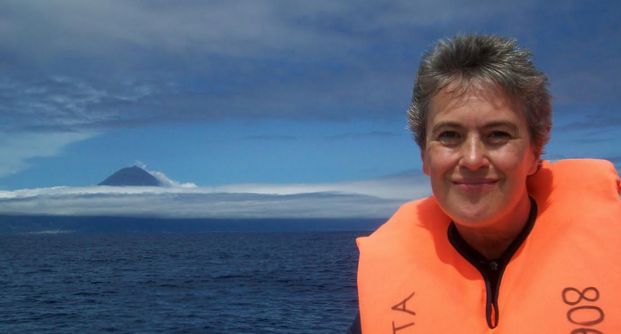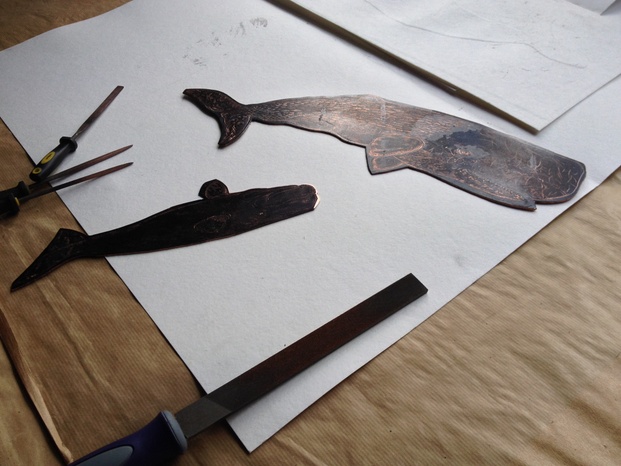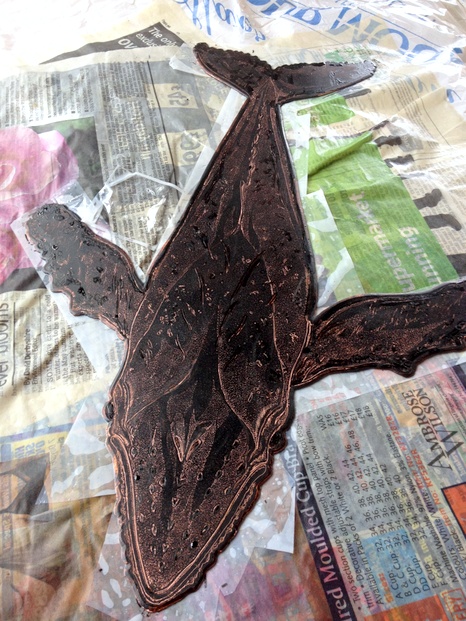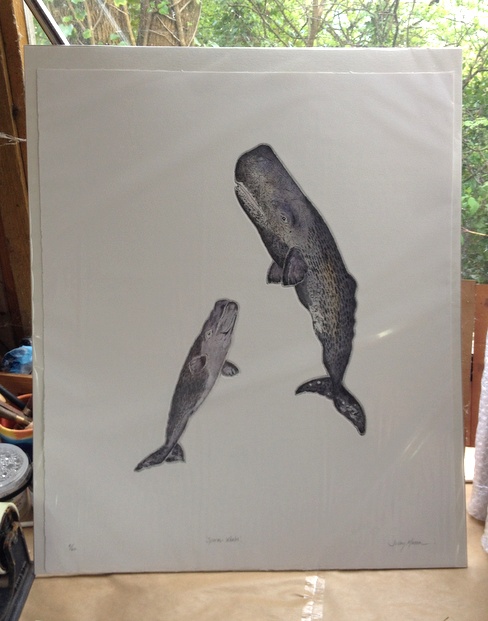
I was extremely fortunate last year to have been able to spend a week on Pico island in the Azores at the home of Dorothy Clarke and her daughter Zoe . Dot and her late husband Malcolm were friends of my parents. Dr.Malcolm Clarke was a fellow of the Royal Society and a world expert on Whales and Cephalopods.
I spent a wonderful day whale watching- vigias ( whale watchers) are sighted around the island in lookouts and can radio locations to the boat. When whales were hunted, signalling would have been done with flags. I love boat rides and travelling at 35 knots through the most incredibly blue sea in bright sunshine was heavenly. I was very fortunate and saw several sperm whales, including a mother suckling her calf. I could not help but think of the time when boats would be chasing these giants with harpoons rather than cameras.
To watch these graceful creatures was a memory I will cherish, to see the tail fin just disappear beneath the waves was truly magical. I also had the chance to snorkel with a pod of Common dolphins, slipping as quietly and with as little splashing as possible over the side of the boat to just lie on the surface and observe the playful antics of these joyful animals. The blue sea was bottomless and as I floated there I could hear the squeaks and calls before I could see them- the noises just permeating through me.
Diving also was extraordinary- the lava cliffs , tunnels, caves and debris from the volcano providing a hugely varied habitat. Parrotfish in all sorts of colours and busy little rainbow wrasse.Crevices with evil looking moray eels, sheer walls covered with soft corals and stunningly beautiful nudibranchs, black sandy gullies dusted with white sand, the perfect camouflage for wide- eyed flounders. Brightly coloured damsel fish protecting their eggs in nests, and a brilliant blue and orange slipper lobster wedged into a crack. Looking up into the blue towards the surface I saw shoals of grey trigger fish.
Swimming through a narrow channel between two cliffs of lava rock, my buddy motioned to me to look- I glanced up, then down and saw an enormous stingray lazily resting on a huge boulder- I jumped! As much as you can when you are diving!! Another stingray, this time a pregnant female was gently swimming away, diving is an amazing experience and to see such creatures at such close quarters is a real privilege. The memories of my time in the Azores, the whales, dolphins, the people and the diving will always be treasured.
These Whales were on show in an exhibition titled ‘Land, sea and Sky ‘ at the Devon Guild in Bovey Tracey. The whales are now on show at the RockSalt restaurant in Stonehouse. Here is the inspiration for the whale pictures…..
The subject matter of my work appears to evolve from memories and by chance from unexpected opportunities. The memories are often influenced by experiences, travel and by people that I have met.
Some of my recent work has included studies of plankton, including Krill – I wanted to move on from the tiniest of amazing creatures to the true giants of the sea, the whales.
Cetacean is from the Greek meaning Sea monster. Worldwide there are about 80 species, 25 of which have been sighted off the Azores.Many of these filter- feeding mammals undertake long migrations because they need warm waters for the growth and development of their young, but they also need the food resources that concentrate in colder waters.The mid Atlantic location of the steep sided volcanic islands create great upwellings of cold water currents from the ocean depths which when meeting the warm waters of the Gulf stream provide nutrient rich waters .Whales have been hunted for centuries, but in early times primitively and in small numbers. In the 18th c whaling spread and predictably, as each species was hunted down, their numbers decreased.With explosive harpoons and motorised boats, the large numbers of whales in Antarctica were exploited with the development of factory ships. Originally, by the British and the Norwegians, then the Germans and the Japanese.In the 1930’s, over 40,000 whales were caught annually , driving some species to near extinction and severely depleting others.The Washington Convention of 1946 attempted to regulate whaling and the numbers allowed to be caught were reduced substantially. However, it was economic factors that caused nations finally to abandon whaling , with the combination of the availability of substitutes, falling prices and the declining stocks.The International Whaling Commission in 1982 agreed zero commercial quotas, but under the guise of research, Norway and Japan continue.The Azores open boat whalers’ annual take , varying from single figures to a few tens, was irrelevant in the context of the industrial catches and whaling finally ceased there in 1987.
Here are a couple of videos of Dr.Malcolm Clarke who was a charming and knowledgeable friend and a great inspiration to me. A fellow of the Royal Society and a world expert on whales and Cephalopods.
A brief video on the Story of the Whale Museum that he set-up on Pico in the Azores
A in-depth and fascinating interview on the inner workings and anatomy of the Spermwhale







No responses yet